
[ad_1]
It’s time to go back to one of Magic players’ favorite planes: Innistrad.
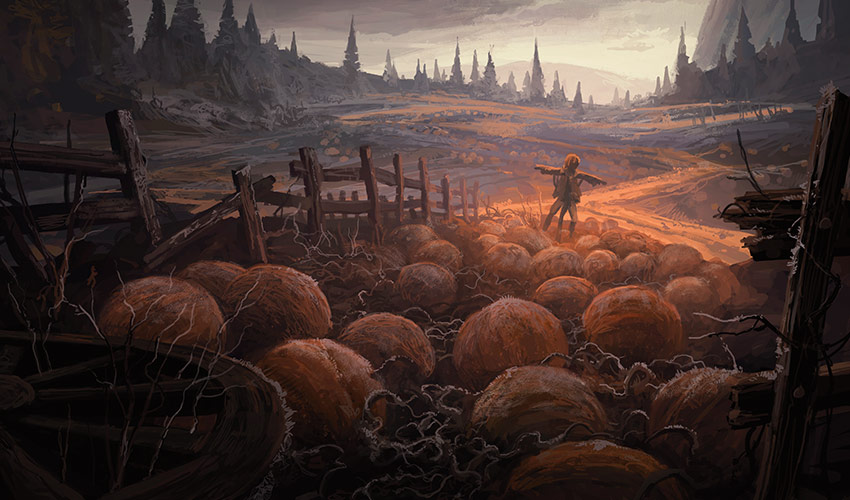
A spooky plane based on gothic horror—filled with Vampires, Werewolves, Zombies, Spirits, and, of course, Humans just trying to get by—loaded with fun and full of flavor. We’re really returning to the heart of Innistrad here, and I cannot wait for you to give it a try.
Whether you’re a Magic veteran or coming in for the first time: welcome, and come check out a Prerelease event at your local game store!
But what is a Prerelease? How do you build a sealed deck?
If you’d prefer to watch some of this information in video format, you can check out my episode of Good Morning Magic here:
Otherwise, to read all about it, grab your closest Blazing Torch and continue onward!
Prereleases have always been my favorite Magic weekends of the year.
During Prerelease weekend, you have your first chance to get your hands on the new set—and to me, the heart and soul of the Prerelease experience is the energy of getting those cards and playing with them. And whether you’re doing that at home or in a store, you’ll still be doing it with so many other people around the world as part of the global experience and conversation. Thanks to the internet, we’re all connected!
The Prerelease of a set is great because the set is totally new, the footing is equal as everybody plays with the set for the very first time, and you just get to relax and have fun exploring the new cards. There’s a lot of laughs, learning, and great games: it’s a lot of fun for old and new players alike!
If you’re a Sealed Deck veteran, you may want to skip ahead to the next section, where I talk about what you can expect for Innistrad: Midnight Hunt. But if you’re new to the world of Prereleases, or are maybe just looking for a few extra pointers, read on!
All right. So, let’s go over perhaps the most important part: finding product for your Prerelease! After all, you can’t very well play if you don’t know where to get the supplies you need.
Well, you’ll need to get in touch with a store. If you don’t already have a local shop you frequent, be sure to check out the store locator to find one near you! That store may even offer preregistration. Prereleases are some of the most popular events we put on, so be sure to check and see if the store preregisters. Be sure to plan ahead.
While, traditionally, Prereleases are run as in-store events, players can also pick up Prerelease Packs and take them home due to COVID-19. We expect some stores will be running in-person events and others will be running virtual ones. In different areas of the world, different rules and restrictions may apply to what can be open—so please take appropriate precautions, be aware of government-level requests, and do only what you feel comfortable with.
Okay now, let’s see. You have a store selected, and you’ve viewed all the awesome cards in the Innistrad: Midnight Hunt Card Image Gallery.
You’re all set and ready to see what this return to Innistrad has to offer! Now it’s time to open some of these new cards!
What does a Prerelease Pack for Innistrad: Midnight Hunt look like? Well, it’s a little something like this:
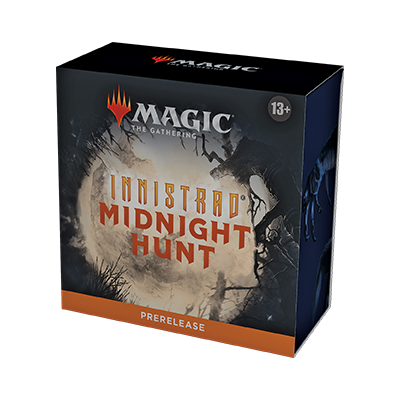
You don’t even have to brave the werewolf-laden forests of Kessig to get one of these beauties. And there is indeed a lot of good stuff inside—here’s everything you’ll get:
- 6 Innistrad: Midnight Hunt Draft Boosters
- 1 Traditional foil rare or mythic rare from Innistrad: Midnight Hunt with a foil year stamp
- Can be a double-faced card
- 3 Double-faced helper cards (with a Magic card back so it can take the place of a double-faced card in a deck, if needed)
- 1 Twenty-sided spindown life counter with the Innistrad: Midnight Hunt expansion symbol imprint
- 1 MTG Arena code card to redeem for Store Packs of Innistrad: Midnight Hunt
- 1 Reusable deck box with divider
The spindown life counters come in all five Magic colors:
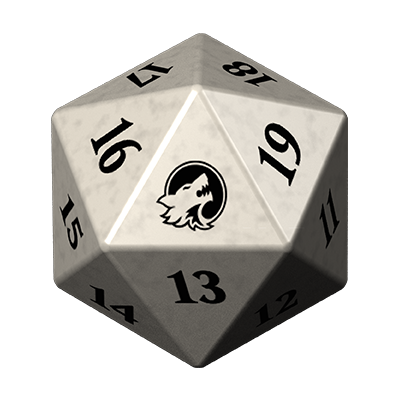
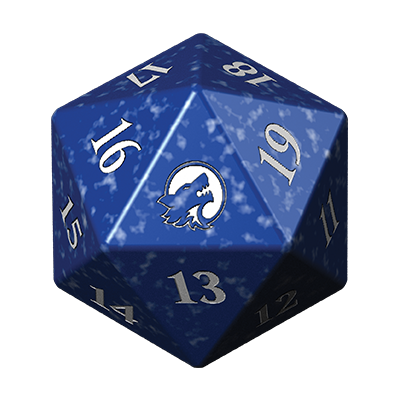
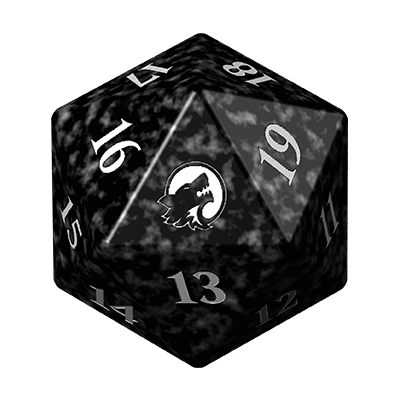
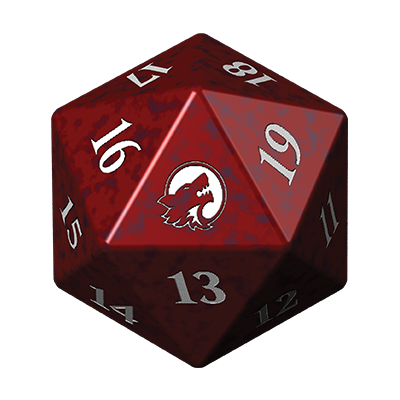
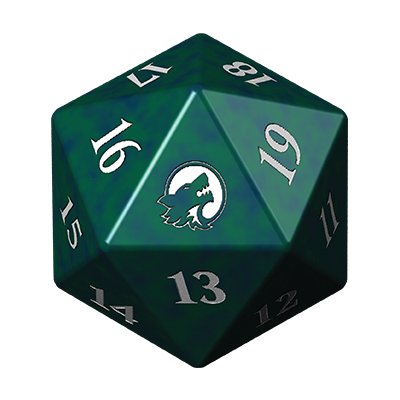
And of course, front and center, are those Draft Boosters.
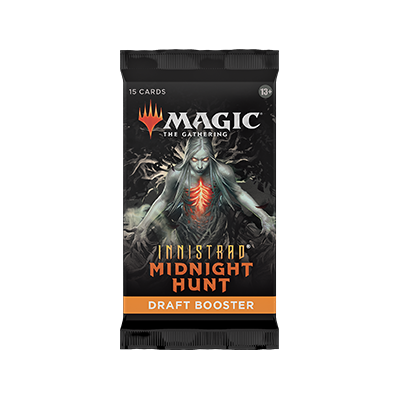
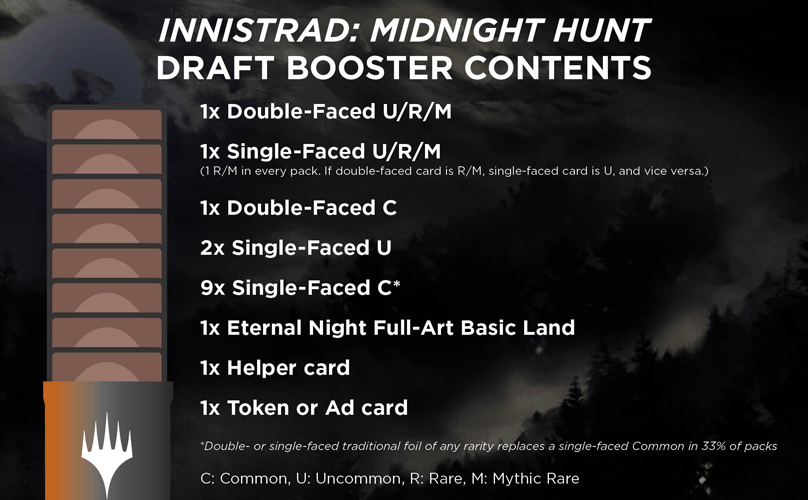
You’ll find six Draft Boosters, which is exactly what you need to get started building your sealed deck. First thing’s first: crack them open! Then, you’ll have a stack of cards.
So . . . what now?
It’s time to build your deck, of course!
Sealed Deck is a little different from normal deck building. You get to build a deck using only the cards in front of you, plus as many basic lands as you’d like. Also, unlike a normal Constructed deck where the minimum deck size is 60, you only need to play 40 cards.
The first thing you’re going to want to do is figure out a method to pick which colors you’ll be playing. I recommend playing two colors and about 23 nonlands. You can sometimes “splash” for a third color, but in general, you’ll want to pick two to be your core.
Some things that may draw you into specific colors are:
- A strong rare you’re excited about
- Plenty of “removal” cards that can deal with your opponent’s creatures
- A lot of playable cards in that color
- A good “mana curve” in that color—meaning lots of creatures of different costs
Ideally, the colors you pick will have all four, but if two or three of those are true, that’s plenty good.
Now you have your colors down. From there, how do you take everything you have and figure out which 22–23 cards to put in your deck?
Here’s one process that may help!
First, lay your creatures out in mana-cost order. This helps you see what creatures you’re going to potentially be able to cast at each part of the game. (Don’t lay your noncreatures out at this point unless they’re cards you are planning to play as soon as you have that much mana—for example, you will generally cast a Ritual Guardian on turn three, whereas Sungold Barrage isn’t usually a turn-three play.)
A good “mana curve” of creatures is crucial to a successful sealed deck. You don’t want to have a ton of cards at any single spot in the curve. It’s important for you to have a good mix so you can play your cheap spells in the early game and your expensive spells in the late game. As a very general rule for Limited, I would look to play something like this:
- 1 mana: 0–2
- 2 mana: 4–6
- 3 mana: 3–5
- 4 mana: 2–4
- 5 mana 1–3
- 6+ mana: 0–2
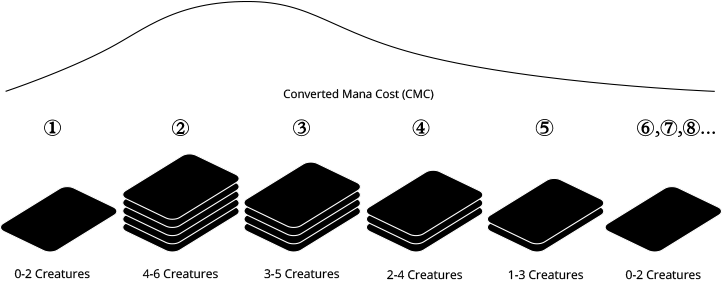
That’s far from hard and fast, but it’s a good place to start. Cull your creatures down to these numbers by choosing your favorites.
Now that you have your core creature base figured out, it’s time to add in spells! Pick your favorites among your colors to bring your deck to 22 or 23 nonlands, and then you’re good to go from the spell side.
The spells you’re going to want most are what are called “removal spells”—these are the spells that permanently neutralize your opponent’s creatures by either dealing damage, keeping them tapped, or just straight-up destroying them. Sealed Deck Magic is all about creatures, so you’ll want to play most of the cards in your colors that can get rid of your opponent’s creatures.
If you want to learn more about mana curves, you can also check out my article on how to build a mana curve by clicking here.
Interested in more tips? Here are a few more things to keep in mind for deck building:
- You can play more than 40 cards, but you really should stick to 40 if possible. Every card you play past 40 just means it’s that much less likely you’re going to draw that awesome rare you put in your deck!
- The land ratio you’re looking at should be about 17 or 18 lands to 23 or 22 nonlands. This isn’t right 100% of the time, but most Limited decks end up looking like this, and, in general, it’s what I would want to have.
- Play a mix of cheap-to-cast and expensive-to-cast cards. If you have all cheap, small creatures, then a single big creature can shut you down. If you have all large, expensive creatures, you risk getting run over first. Stick to a mix that focuses on creatures with a mana value of two, three, four, and five. More games of Sealed Deck are won by casting a creature every turn starting on turn two or three than by any other way.
- Evasion is important! Often, Sealed Deck games will get into stalls where both players have a lot of creatures and neither player can attack very well. Creatures with abilities like flying ensure that you can break through these creature stalls.
- Unlike most Magic formats, Sealed tends to be a little slower. If your deck is on the slow side, choosing to draw (go second) rather than play (go first) can be reasonable to give you that extra card.
Innistrad: Midnight Hunt has a bunch of spectacular frame treatments!
To see all of them in a video, check out my episode of Good Morning Magic where I cover all of them:
Or if you’d rather read about them, let’s dig in here.
We have a few different frames—like the equinox frame, found on Werewolves and Warlocks:
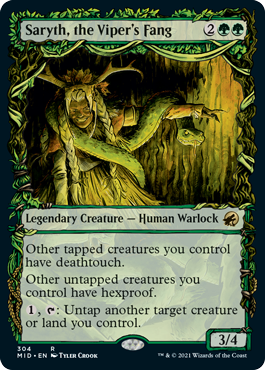
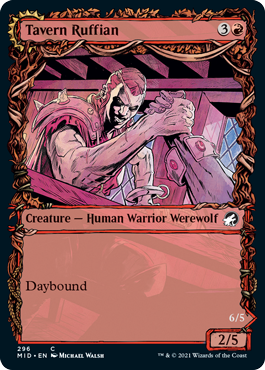
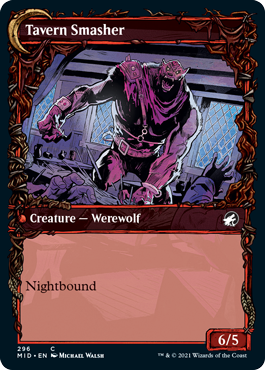
We also have the eternal night frame, both on legendary non-Werewolf and -Warlock creatures in the set:
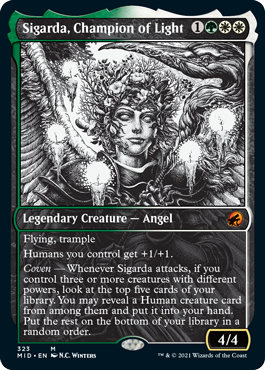
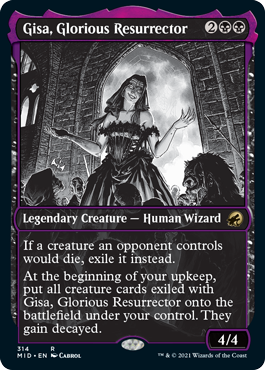
Plus, the gorgeous eternal night basic lands—which you can find one of in every Draft Booster!
Eternal night cards—both non-foil and traditional foil variants—also received a special gloss varnish on the pin-line of the frames, as well as the mana symbols on eternal night basic lands, to give these elements a subtle, elevated shine.
There’s also this great treatment on the pin-lines of these cards—to check out what they look like in person, watch this very quick 17-second video showing off both:
On top of that, we of course have borderless planeswalkers:
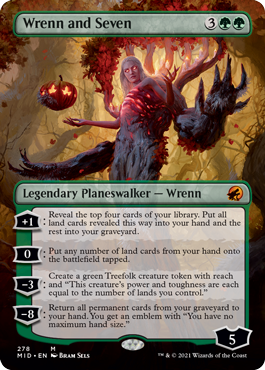
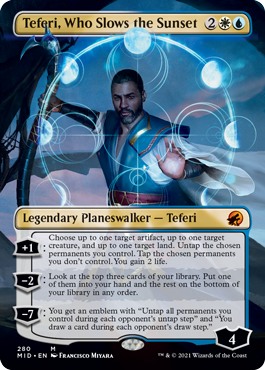
And also borderless dual lands! The brand-new dual lands show up in this style as well and really make the colors of Innistrad shine through:
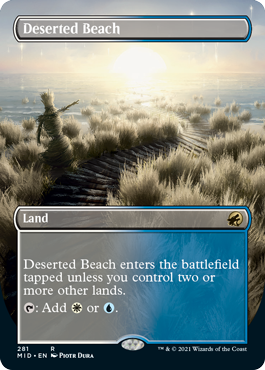
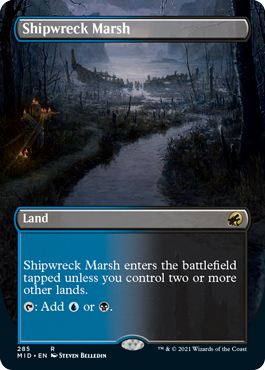
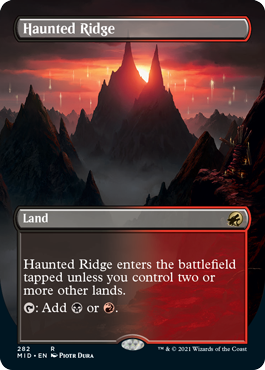
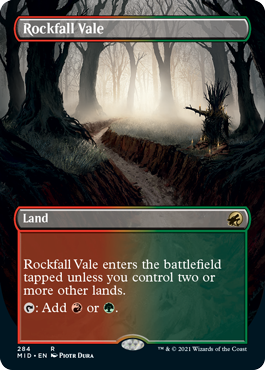
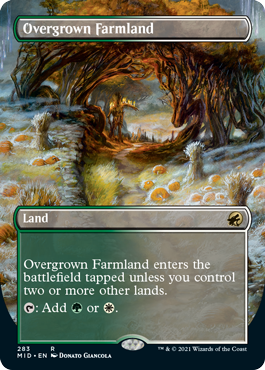
To see everything that’s happening, and where to find it, go check out the Collecting Innistrad: Midnight Hunt article.
Depending on where in the world you are, playing Magic in a store may be a challenge right now due to COVID-19. So, if you get product to bring home and aren’t able to, or don’t feel comfortable playing in a store, what should you do?
Well, of course there’s Magic: The Gathering Online and Magic: The Gathering Arena, both of which let you play the set from a safe distance. But on the other hand, you could try playing over a phone camera or webcam!
If you haven’t tried SpellTable yet, it’s really fantastic: with just a few clicks, you can set up your phone or computer with webcam to play Magic with someone across town—or across the world. Complete with life-total tracking and card lookup, it’s really easy to set up: just log in with your Wizards account, and you’re good to go.
Some stores will even be offering remote Prerelease play opportunities using SpellTable, and there are many places out there organizing times to play. Be sure to talk with your local store to see what they might be doing in the way of online events.
And for more information on using SpellTable, you can also check out my video here:
While you’re at your store to pick up Prerelease Packs, you can also buy other things—like Set and Collector Booster Boxes! Be sure to call ahead to preorder one, and while supplies last, you should be able to pick one up.
When you grab a box from your local game store, you can also grab one of these (while supplies last) to boot:
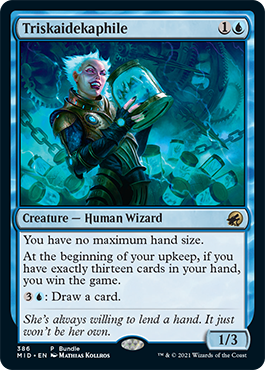
Whether a returning mechanic like flashback or a new one like disturb, there’s plenty to look at here in Innistrad: Midnight Hunt. Learn how the mechanics of the set work with these great videos:
I started at Wizards 10 years ago—right when Innistrad was the newest set. Here we are, 10 years later, with a whole new Innistrad set that really feels like a return to the original . . . and I’m thrilled to see a whole new generation of players, and longtime fans, coming to check it out. I hope you have a blast with it!
If you have any questions at all, feel free to hit me up on Twitter, Tumblr, Instagram, TikTok, YouTube, or even by sending an email to BeyondBasicsMagic@gmail.com. I’d be happy to hear from you!
Whenever and however you play with the set, have a blast! And . . . be careful out there. You never know what you might find on this plane.
Talk with you again soon,
Gavin
Email: BeyondBasicsMagic@gmail.com
Instagram: GavinVerhey
TikTok: @GavinVerhey
Tumblr: GavInsight
Twitter: @GavinVerhey
YouTube: Good Morning Magic
[ad_2]





